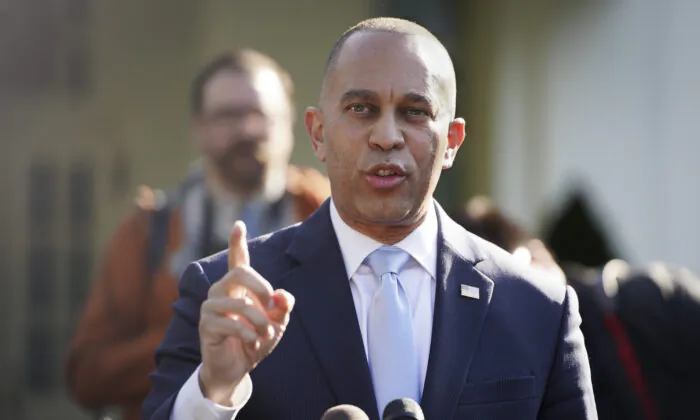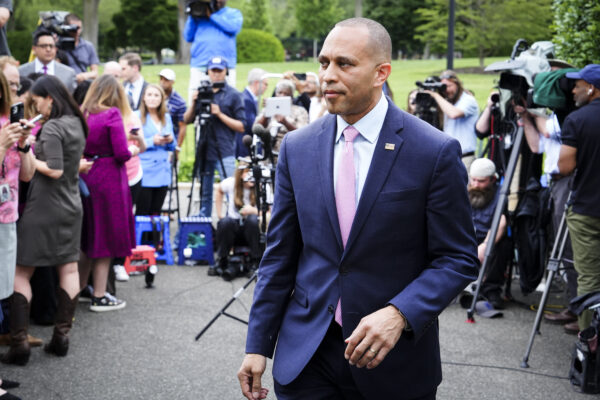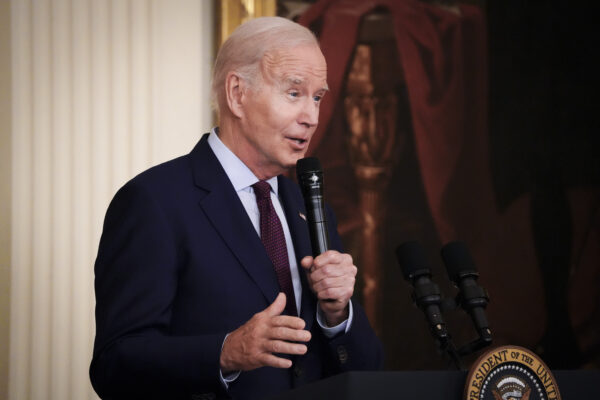
House Minority Leader Hakeem Jeffries (D-N.Y.) speaks to the press after
meeting President Joe Biden and other leaders at the White House in
Washington on May 9, 2023. (Madalina Vasiliu/The Epoch Times)
House Democrats on Wednesday formally introduced a procedural resolution referred to as a “discharge petition” in an effort to try and force a floor vote on a U.S. debt limit increase without needing the approval of House Speaker Kevin McCarthy (R-Calif.).
The discharge petition was introduced at 10 a.m. as part of a clandestine scheme that had been quietly set in motion since the start of January. The top House Democrat, Rep. Hakeem Jeffries (D-N.Y.), first alerted fellow Democrat colleagues to the plan on May 2.
At the time, he told colleagues that a bill titled “Breaking the Gridlock Act” was introduced at the start of the 118th Congress that had multiple items on it, but also later had a clean debt ceiling increase attached to it. The bill, brought by Rep. Mark DeSaulnier (D-Calif.) has remained untouched since March 7, when it was referred to 20 different House committees.
A discharge petition, a rarely-used procedural measure, would bring a bill out of committee and force a floor vote, if the bill has remained idle for more than 30 days. This would happen even without the approval of the House Speaker.
On Wednesday, Jeffries urged all members of his caucus to support a discharge petition for DeSaulnier’s bill.

In a “dear colleague” letter (pdf), he expressed hope to find an “acceptable, bipartisan resolution that prevents a default,” but noted that because of the impending June 1 U.S. default deadline, “it is important that all legislative options be pursued in the event that no agreement is reached.”
He said a discharge petition is “a vehicle that may be necessary to protect the full faith and credit of the United States,” adding, “It is imperative that Members make every effort to sign the discharge petition today.”
To file the petition and succeed in forcing a House floor vote, Democrats need the support of a majority of the House or 218 votes. If all 213 House Democrats vote in support, the effort would still require at least five House Republicans to join them.
Currently, it is unclear whether all Democrats support the discharge petition.
Standoff Since January
Since January, President Joe Biden has had a standoff with McCarthy over raising the nation’s $31.4 trillion debt ceiling.
Republicans, who control the House by a 222-213 majority, have been pushing for spending cuts in exchange for a deal with Democrats to raise Congress’s self-imposed debt limit.
The government usually spends more than it takes in taxes, so borrowing is needed each year to meet the spending obligations legislated by Congress, which requires raising the debt limit.
The U.S. Treasury has indicated it will be unable to stay under the limit after about June 1. This means the U.S. government won’t be able to pay its bills if the debt limit isn’t lifted. Economists have said this would trigger a recession.
Deal by May 21 ‘Doable’: McCarthy
After a meeting to discuss the debt ceiling with McCarthy and other leaders on May 16—the second such meeting in eight days—Biden told reporters on May 17 the meeting was “productive,” adding he was “confident” that an agreement would be reached on the budget and there won’t be a federal default.
“The nation has never defaulted on its debt, and it never will,” he told reporters at the White House ahead of his departure that day to attend a G-7 Summit in Hiroshima, Japan.
“And we’re going to continue these discussions with congressional leaders in the coming days until we reach an agreement.”
When asked by reporters at the U.S. Capitol whether it’s possible to reach a debt ceiling deal by the time Biden returns from Asia on May 21, McCarthy said it is “doable.”
“We’re on such a short timeline,” he told reporters. “It makes it almost harder. But there’s one thing you know, for me, I never give up. I have the grit, the perseverance and we’re gonna get it done.”

Biden on Wednesday signaled that he might accept work requirement expansions as part of the compromise with Republicans to raise the debt ceiling, so long as they don’t affect health care programs.
Meanwhile, McCarthy, in a CNBC interview, defended conservatives’ call for work requirements, saying they would help the economy and boost the workforce, and vowed to exclude any discussion of taxes.
Raising taxes on the wealthy and companies to help pay for programs for other Americans is a key part of Biden’s 2024 budget. On Tuesday, Biden said he was disappointed that Republicans would not consider ways to raise revenue.
If a deal is reached in the House and successfully passes, the Senate must still vote on the measure. Democrats hold a 51-49 majority in the Senate. The deal, with the backing of all Senate Democrats, would still require the support of nine Republicans to be passed.
Lawrence Wilson and Reuters contributed to this report.
No comments:
Post a Comment